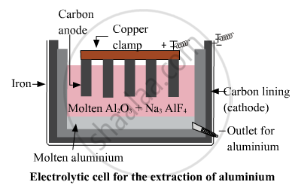Advertisements
Advertisements
प्रश्न
Answer the following question:
Carbon cannot reduce the oxides of sodium, magnesium, and aluminum to their respective metals. Why? Where are these metals placed in the reactivity series? How are these metals obtained from their ores? Take an example to explain the process of extraction along with chemical equations.
उत्तर
Oxides of sodium, magnesium and aluminium are very strong oxides as these metal are very reactive metals, but carbon is not a strong reducing agent and hence cannot reduce the reactive metal oxides to metals.
In the reactivity series, sodium, magnesium and aluminium are placed in the upper portion which means these metals are very reactive in nature and carbon is less reactive.
K > Na > Ca > Mg > Al > C > Zn > Fe
Oxides of reactive metals are directly put for electrolytic reduction process to obtain the pure metal.
For the oxide of a reactive metal like aluminium oxide, as the metal is already in its oxide state so, it is directly put for the electrolytic reduction process. In this process, graphite electrodes are used as anode and cathode in the electrolytic chamber. The pure aluminium is attracted to the cathode, which is a lining of graphite. The oxygen is attracted to the anode, and bubbles through the solution.
Cathode reaction: at cathode reduction of aluminium takes place and thus aluminium is discharged at the cathode.
\[\ce{Al^3+ + 3e- -> Al}\]
Anode reaction: at anode oxidation takes place and oxygen gas is evolved.
\[\ce{2O^2- -> O2 + 4e-}\]

संबंधित प्रश्न
Name the gas produced when calamine ore is calcined.
Name the electrode at which aluminium metal is produced.
Some metallic oxides can be reduced by hydrogen, carbon and carbon monoxide and some cannot. Explain.
Give reasons, why aluminum is used in:
painting electric and telegraphic poles
An element has its electron configuration as 2,8,8,2. Now answer the following questions.
a) What is the atomic number of this element?
b) What is the group of this element?
c) To which period does this element belong?
Define the following term.
Gangue
Give the chemical formula of :
Cryolite
Complete the incomplete statement with missing word:
Metals form positive ions while non- metals ______.
How many valence electrons are present in non- metals?
Explain concept with example/explain with the help of a balanced equation.
Ionic bond and ionic compounds
